ECON251 - China's Economic Slowdown: An In-Depth Analysis
VerifiedAdded on 2023/06/03
|8
|1851
|477
Essay
AI Summary
This essay examines the economic slowdown in China, analyzing its causes, including population aging, wage increases, and a shift from investment-driven to consumption-driven growth. The essay explores the impact on global commodity markets, particularly the decline in demand for oil, copper, and other resources, and the resulting volatility in commodity prices. It further details the consequences for emerging economies, advanced nations, and the global financial system, including the potential for a credit crisis. The essay discusses the devaluation of the renminbi and its effects on international trade. It concludes by suggesting that while there are short-term negative impacts, there is hope that China will overcome its slowdown with its large consumer base and that resource-rich countries should diversify their revenue sources. The essay emphasizes the need for investors to be aware of the potential credit crisis associated with China's economic slowdown.
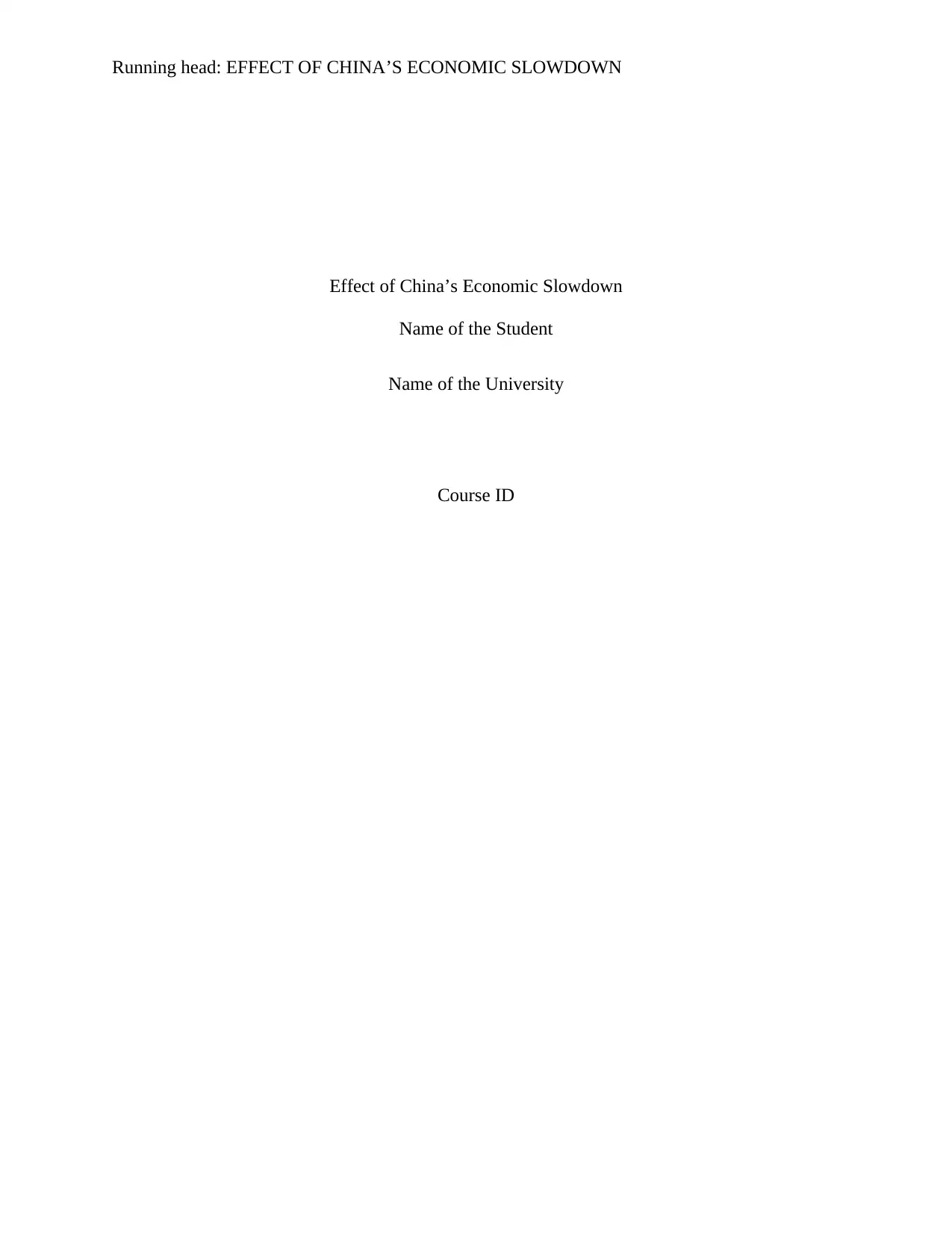
Running head: EFFECT OF CHINA’S ECONOMIC SLOWDOWN
Effect of China’s Economic Slowdown
Name of the Student
Name of the University
Course ID
Effect of China’s Economic Slowdown
Name of the Student
Name of the University
Course ID
Paraphrase This Document
Need a fresh take? Get an instant paraphrase of this document with our AI Paraphraser
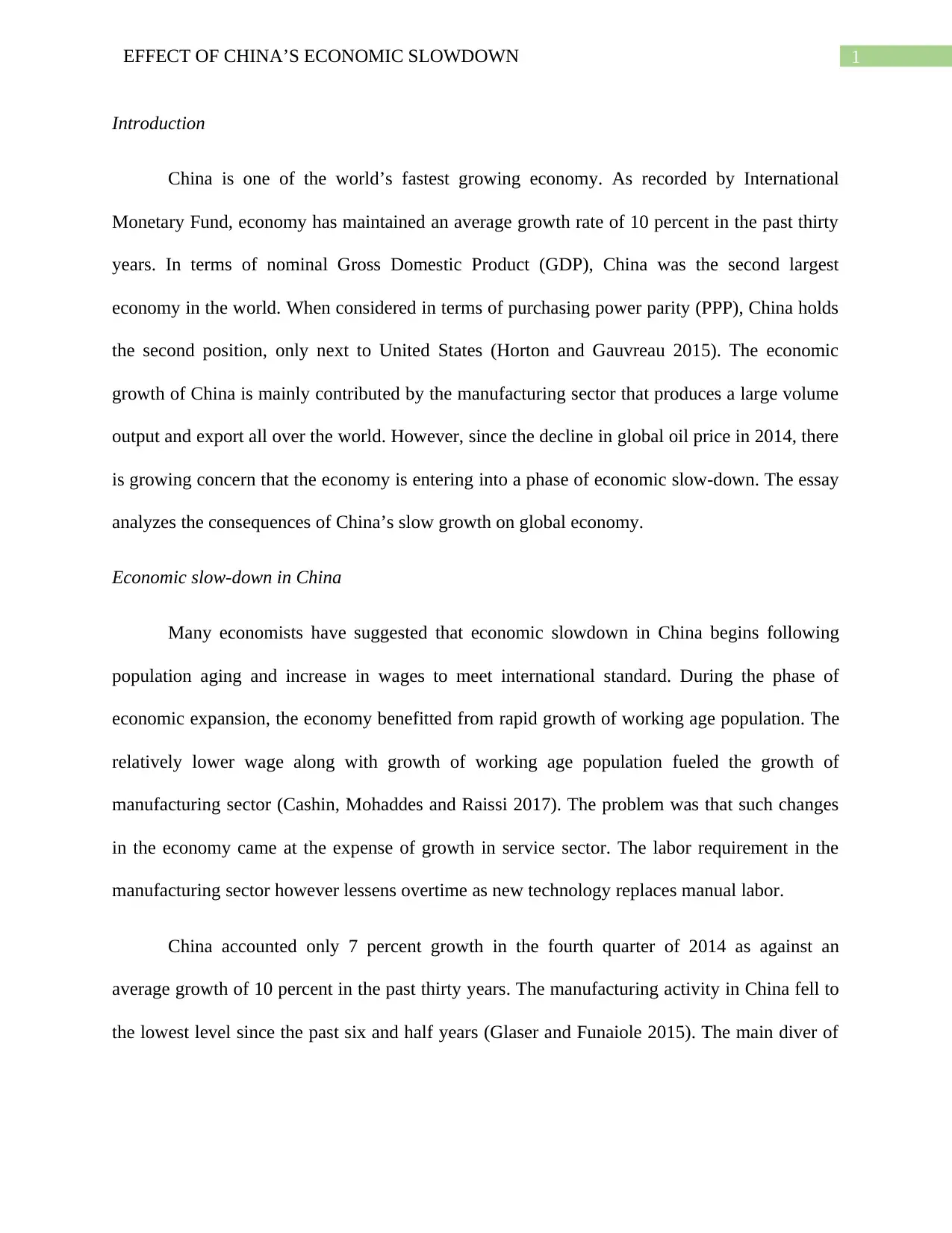
1EFFECT OF CHINA’S ECONOMIC SLOWDOWN
Introduction
China is one of the world’s fastest growing economy. As recorded by International
Monetary Fund, economy has maintained an average growth rate of 10 percent in the past thirty
years. In terms of nominal Gross Domestic Product (GDP), China was the second largest
economy in the world. When considered in terms of purchasing power parity (PPP), China holds
the second position, only next to United States (Horton and Gauvreau 2015). The economic
growth of China is mainly contributed by the manufacturing sector that produces a large volume
output and export all over the world. However, since the decline in global oil price in 2014, there
is growing concern that the economy is entering into a phase of economic slow-down. The essay
analyzes the consequences of China’s slow growth on global economy.
Economic slow-down in China
Many economists have suggested that economic slowdown in China begins following
population aging and increase in wages to meet international standard. During the phase of
economic expansion, the economy benefitted from rapid growth of working age population. The
relatively lower wage along with growth of working age population fueled the growth of
manufacturing sector (Cashin, Mohaddes and Raissi 2017). The problem was that such changes
in the economy came at the expense of growth in service sector. The labor requirement in the
manufacturing sector however lessens overtime as new technology replaces manual labor.
China accounted only 7 percent growth in the fourth quarter of 2014 as against an
average growth of 10 percent in the past thirty years. The manufacturing activity in China fell to
the lowest level since the past six and half years (Glaser and Funaiole 2015). The main diver of
Introduction
China is one of the world’s fastest growing economy. As recorded by International
Monetary Fund, economy has maintained an average growth rate of 10 percent in the past thirty
years. In terms of nominal Gross Domestic Product (GDP), China was the second largest
economy in the world. When considered in terms of purchasing power parity (PPP), China holds
the second position, only next to United States (Horton and Gauvreau 2015). The economic
growth of China is mainly contributed by the manufacturing sector that produces a large volume
output and export all over the world. However, since the decline in global oil price in 2014, there
is growing concern that the economy is entering into a phase of economic slow-down. The essay
analyzes the consequences of China’s slow growth on global economy.
Economic slow-down in China
Many economists have suggested that economic slowdown in China begins following
population aging and increase in wages to meet international standard. During the phase of
economic expansion, the economy benefitted from rapid growth of working age population. The
relatively lower wage along with growth of working age population fueled the growth of
manufacturing sector (Cashin, Mohaddes and Raissi 2017). The problem was that such changes
in the economy came at the expense of growth in service sector. The labor requirement in the
manufacturing sector however lessens overtime as new technology replaces manual labor.
China accounted only 7 percent growth in the fourth quarter of 2014 as against an
average growth of 10 percent in the past thirty years. The manufacturing activity in China fell to
the lowest level since the past six and half years (Glaser and Funaiole 2015). The main diver of
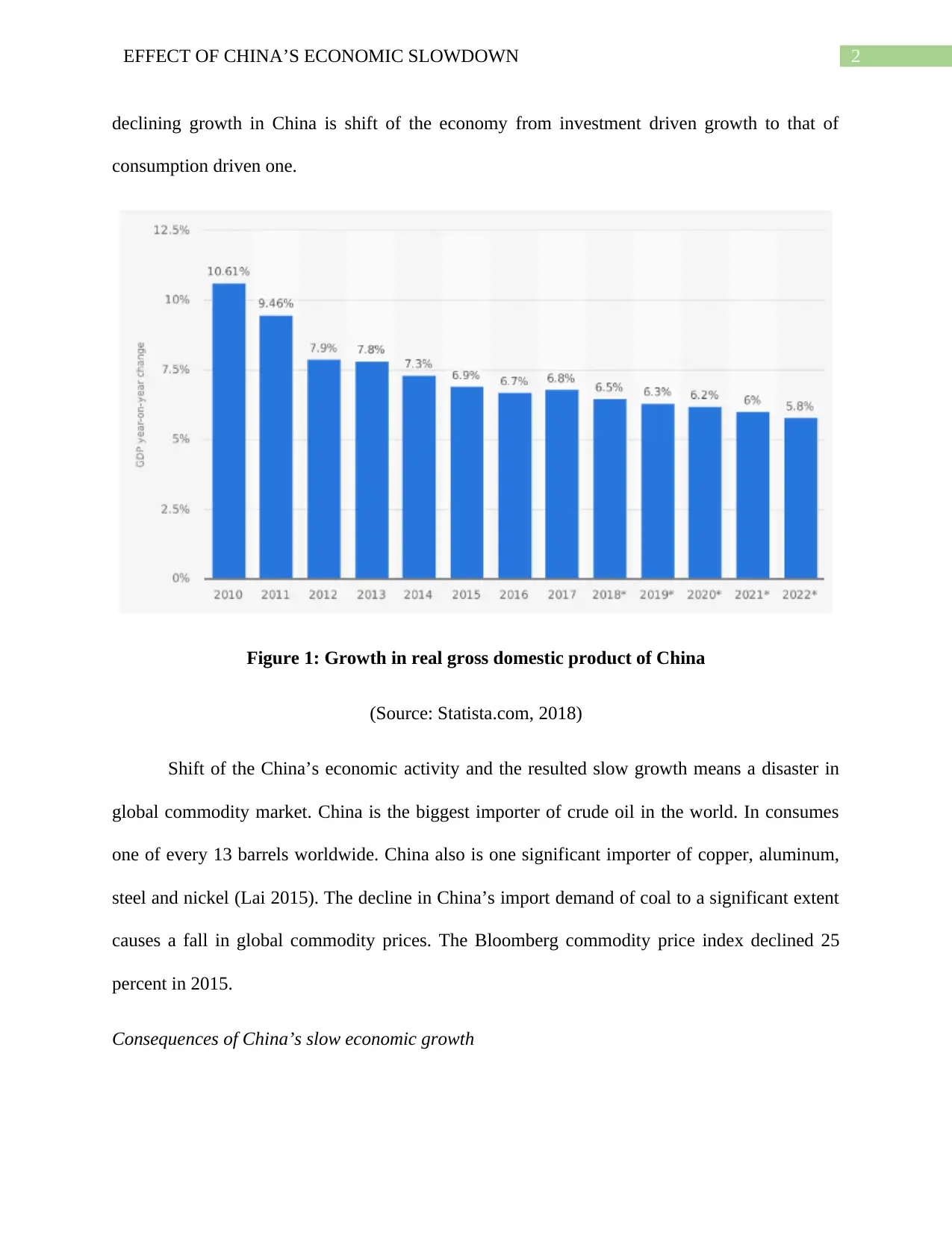
2EFFECT OF CHINA’S ECONOMIC SLOWDOWN
declining growth in China is shift of the economy from investment driven growth to that of
consumption driven one.
Figure 1: Growth in real gross domestic product of China
(Source: Statista.com, 2018)
Shift of the China’s economic activity and the resulted slow growth means a disaster in
global commodity market. China is the biggest importer of crude oil in the world. In consumes
one of every 13 barrels worldwide. China also is one significant importer of copper, aluminum,
steel and nickel (Lai 2015). The decline in China’s import demand of coal to a significant extent
causes a fall in global commodity prices. The Bloomberg commodity price index declined 25
percent in 2015.
Consequences of China’s slow economic growth
declining growth in China is shift of the economy from investment driven growth to that of
consumption driven one.
Figure 1: Growth in real gross domestic product of China
(Source: Statista.com, 2018)
Shift of the China’s economic activity and the resulted slow growth means a disaster in
global commodity market. China is the biggest importer of crude oil in the world. In consumes
one of every 13 barrels worldwide. China also is one significant importer of copper, aluminum,
steel and nickel (Lai 2015). The decline in China’s import demand of coal to a significant extent
causes a fall in global commodity prices. The Bloomberg commodity price index declined 25
percent in 2015.
Consequences of China’s slow economic growth
⊘ This is a preview!⊘
Do you want full access?
Subscribe today to unlock all pages.

Trusted by 1+ million students worldwide
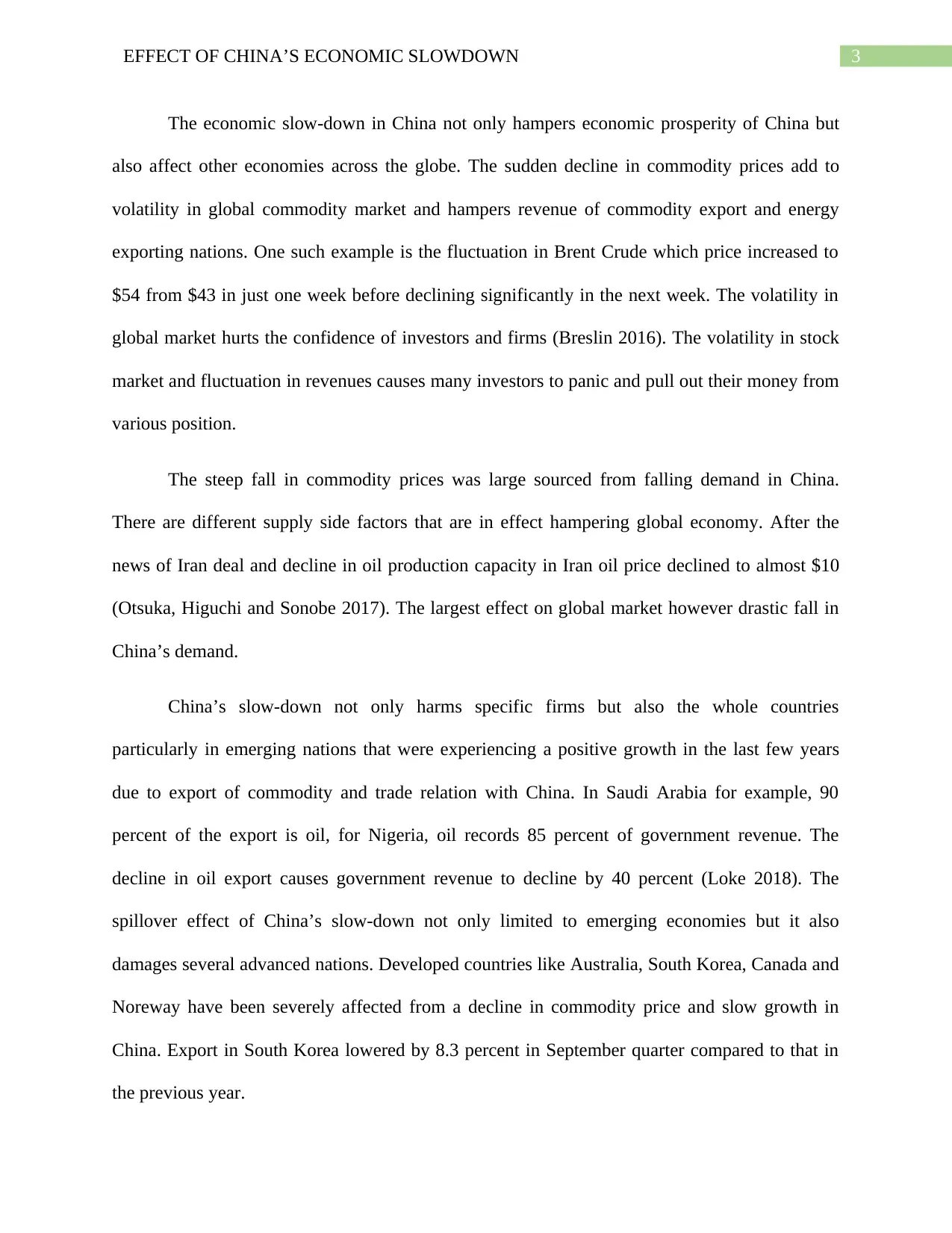
3EFFECT OF CHINA’S ECONOMIC SLOWDOWN
The economic slow-down in China not only hampers economic prosperity of China but
also affect other economies across the globe. The sudden decline in commodity prices add to
volatility in global commodity market and hampers revenue of commodity export and energy
exporting nations. One such example is the fluctuation in Brent Crude which price increased to
$54 from $43 in just one week before declining significantly in the next week. The volatility in
global market hurts the confidence of investors and firms (Breslin 2016). The volatility in stock
market and fluctuation in revenues causes many investors to panic and pull out their money from
various position.
The steep fall in commodity prices was large sourced from falling demand in China.
There are different supply side factors that are in effect hampering global economy. After the
news of Iran deal and decline in oil production capacity in Iran oil price declined to almost $10
(Otsuka, Higuchi and Sonobe 2017). The largest effect on global market however drastic fall in
China’s demand.
China’s slow-down not only harms specific firms but also the whole countries
particularly in emerging nations that were experiencing a positive growth in the last few years
due to export of commodity and trade relation with China. In Saudi Arabia for example, 90
percent of the export is oil, for Nigeria, oil records 85 percent of government revenue. The
decline in oil export causes government revenue to decline by 40 percent (Loke 2018). The
spillover effect of China’s slow-down not only limited to emerging economies but it also
damages several advanced nations. Developed countries like Australia, South Korea, Canada and
Noreway have been severely affected from a decline in commodity price and slow growth in
China. Export in South Korea lowered by 8.3 percent in September quarter compared to that in
the previous year.
The economic slow-down in China not only hampers economic prosperity of China but
also affect other economies across the globe. The sudden decline in commodity prices add to
volatility in global commodity market and hampers revenue of commodity export and energy
exporting nations. One such example is the fluctuation in Brent Crude which price increased to
$54 from $43 in just one week before declining significantly in the next week. The volatility in
global market hurts the confidence of investors and firms (Breslin 2016). The volatility in stock
market and fluctuation in revenues causes many investors to panic and pull out their money from
various position.
The steep fall in commodity prices was large sourced from falling demand in China.
There are different supply side factors that are in effect hampering global economy. After the
news of Iran deal and decline in oil production capacity in Iran oil price declined to almost $10
(Otsuka, Higuchi and Sonobe 2017). The largest effect on global market however drastic fall in
China’s demand.
China’s slow-down not only harms specific firms but also the whole countries
particularly in emerging nations that were experiencing a positive growth in the last few years
due to export of commodity and trade relation with China. In Saudi Arabia for example, 90
percent of the export is oil, for Nigeria, oil records 85 percent of government revenue. The
decline in oil export causes government revenue to decline by 40 percent (Loke 2018). The
spillover effect of China’s slow-down not only limited to emerging economies but it also
damages several advanced nations. Developed countries like Australia, South Korea, Canada and
Noreway have been severely affected from a decline in commodity price and slow growth in
China. Export in South Korea lowered by 8.3 percent in September quarter compared to that in
the previous year.
Paraphrase This Document
Need a fresh take? Get an instant paraphrase of this document with our AI Paraphraser
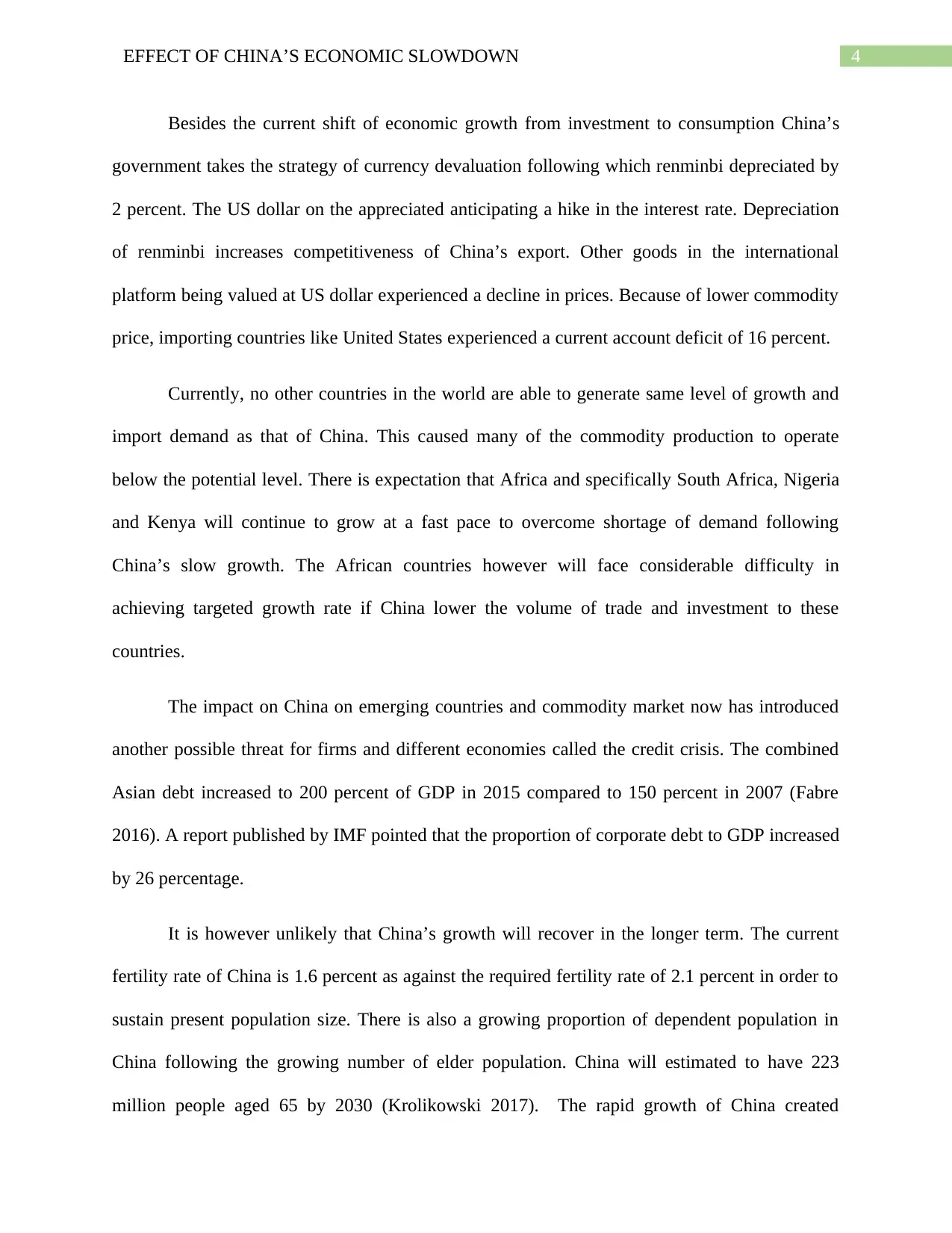
4EFFECT OF CHINA’S ECONOMIC SLOWDOWN
Besides the current shift of economic growth from investment to consumption China’s
government takes the strategy of currency devaluation following which renminbi depreciated by
2 percent. The US dollar on the appreciated anticipating a hike in the interest rate. Depreciation
of renminbi increases competitiveness of China’s export. Other goods in the international
platform being valued at US dollar experienced a decline in prices. Because of lower commodity
price, importing countries like United States experienced a current account deficit of 16 percent.
Currently, no other countries in the world are able to generate same level of growth and
import demand as that of China. This caused many of the commodity production to operate
below the potential level. There is expectation that Africa and specifically South Africa, Nigeria
and Kenya will continue to grow at a fast pace to overcome shortage of demand following
China’s slow growth. The African countries however will face considerable difficulty in
achieving targeted growth rate if China lower the volume of trade and investment to these
countries.
The impact on China on emerging countries and commodity market now has introduced
another possible threat for firms and different economies called the credit crisis. The combined
Asian debt increased to 200 percent of GDP in 2015 compared to 150 percent in 2007 (Fabre
2016). A report published by IMF pointed that the proportion of corporate debt to GDP increased
by 26 percentage.
It is however unlikely that China’s growth will recover in the longer term. The current
fertility rate of China is 1.6 percent as against the required fertility rate of 2.1 percent in order to
sustain present population size. There is also a growing proportion of dependent population in
China following the growing number of elder population. China will estimated to have 223
million people aged 65 by 2030 (Krolikowski 2017). The rapid growth of China created
Besides the current shift of economic growth from investment to consumption China’s
government takes the strategy of currency devaluation following which renminbi depreciated by
2 percent. The US dollar on the appreciated anticipating a hike in the interest rate. Depreciation
of renminbi increases competitiveness of China’s export. Other goods in the international
platform being valued at US dollar experienced a decline in prices. Because of lower commodity
price, importing countries like United States experienced a current account deficit of 16 percent.
Currently, no other countries in the world are able to generate same level of growth and
import demand as that of China. This caused many of the commodity production to operate
below the potential level. There is expectation that Africa and specifically South Africa, Nigeria
and Kenya will continue to grow at a fast pace to overcome shortage of demand following
China’s slow growth. The African countries however will face considerable difficulty in
achieving targeted growth rate if China lower the volume of trade and investment to these
countries.
The impact on China on emerging countries and commodity market now has introduced
another possible threat for firms and different economies called the credit crisis. The combined
Asian debt increased to 200 percent of GDP in 2015 compared to 150 percent in 2007 (Fabre
2016). A report published by IMF pointed that the proportion of corporate debt to GDP increased
by 26 percentage.
It is however unlikely that China’s growth will recover in the longer term. The current
fertility rate of China is 1.6 percent as against the required fertility rate of 2.1 percent in order to
sustain present population size. There is also a growing proportion of dependent population in
China following the growing number of elder population. China will estimated to have 223
million people aged 65 by 2030 (Krolikowski 2017). The rapid growth of China created
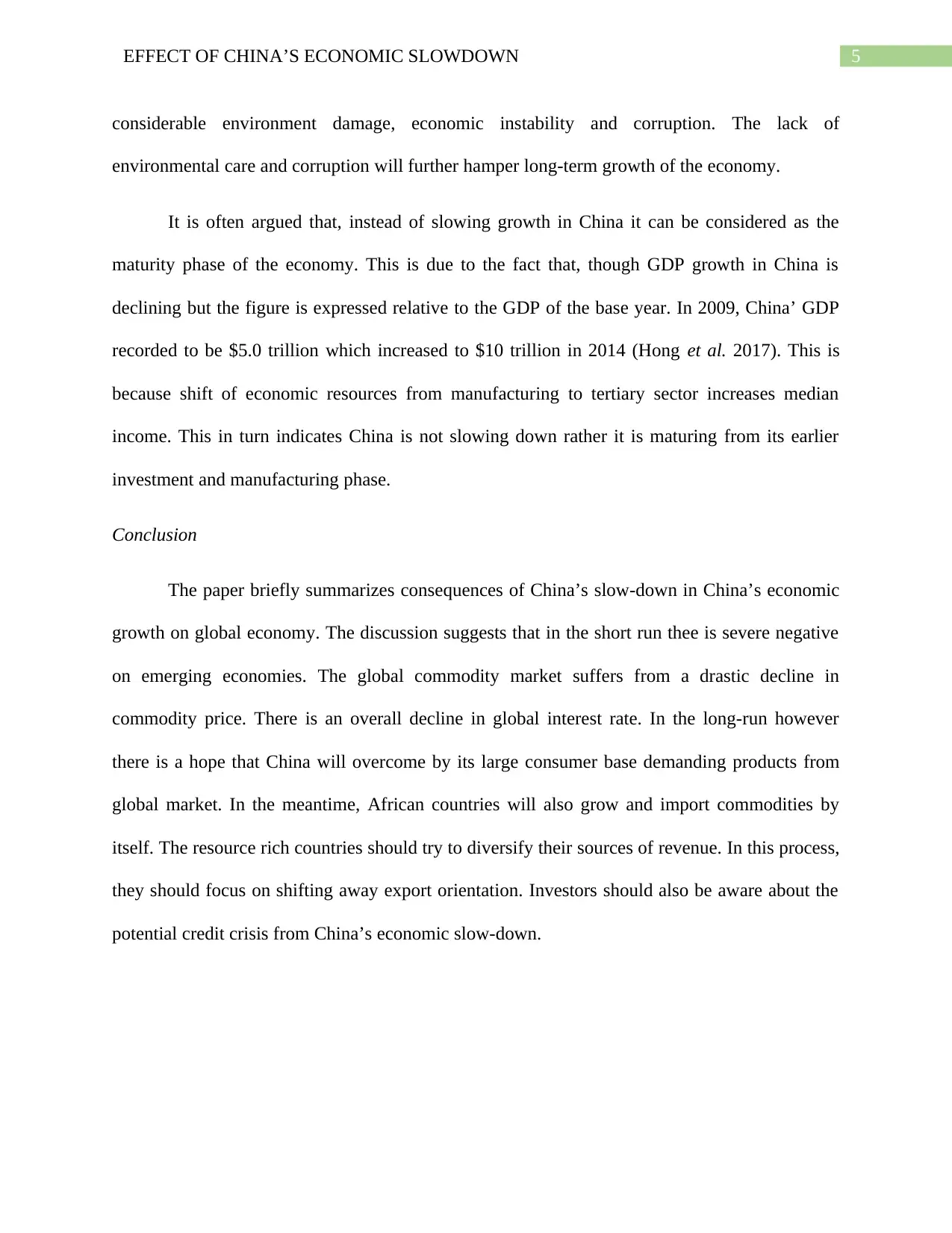
5EFFECT OF CHINA’S ECONOMIC SLOWDOWN
considerable environment damage, economic instability and corruption. The lack of
environmental care and corruption will further hamper long-term growth of the economy.
It is often argued that, instead of slowing growth in China it can be considered as the
maturity phase of the economy. This is due to the fact that, though GDP growth in China is
declining but the figure is expressed relative to the GDP of the base year. In 2009, China’ GDP
recorded to be $5.0 trillion which increased to $10 trillion in 2014 (Hong et al. 2017). This is
because shift of economic resources from manufacturing to tertiary sector increases median
income. This in turn indicates China is not slowing down rather it is maturing from its earlier
investment and manufacturing phase.
Conclusion
The paper briefly summarizes consequences of China’s slow-down in China’s economic
growth on global economy. The discussion suggests that in the short run thee is severe negative
on emerging economies. The global commodity market suffers from a drastic decline in
commodity price. There is an overall decline in global interest rate. In the long-run however
there is a hope that China will overcome by its large consumer base demanding products from
global market. In the meantime, African countries will also grow and import commodities by
itself. The resource rich countries should try to diversify their sources of revenue. In this process,
they should focus on shifting away export orientation. Investors should also be aware about the
potential credit crisis from China’s economic slow-down.
considerable environment damage, economic instability and corruption. The lack of
environmental care and corruption will further hamper long-term growth of the economy.
It is often argued that, instead of slowing growth in China it can be considered as the
maturity phase of the economy. This is due to the fact that, though GDP growth in China is
declining but the figure is expressed relative to the GDP of the base year. In 2009, China’ GDP
recorded to be $5.0 trillion which increased to $10 trillion in 2014 (Hong et al. 2017). This is
because shift of economic resources from manufacturing to tertiary sector increases median
income. This in turn indicates China is not slowing down rather it is maturing from its earlier
investment and manufacturing phase.
Conclusion
The paper briefly summarizes consequences of China’s slow-down in China’s economic
growth on global economy. The discussion suggests that in the short run thee is severe negative
on emerging economies. The global commodity market suffers from a drastic decline in
commodity price. There is an overall decline in global interest rate. In the long-run however
there is a hope that China will overcome by its large consumer base demanding products from
global market. In the meantime, African countries will also grow and import commodities by
itself. The resource rich countries should try to diversify their sources of revenue. In this process,
they should focus on shifting away export orientation. Investors should also be aware about the
potential credit crisis from China’s economic slow-down.
⊘ This is a preview!⊘
Do you want full access?
Subscribe today to unlock all pages.

Trusted by 1+ million students worldwide
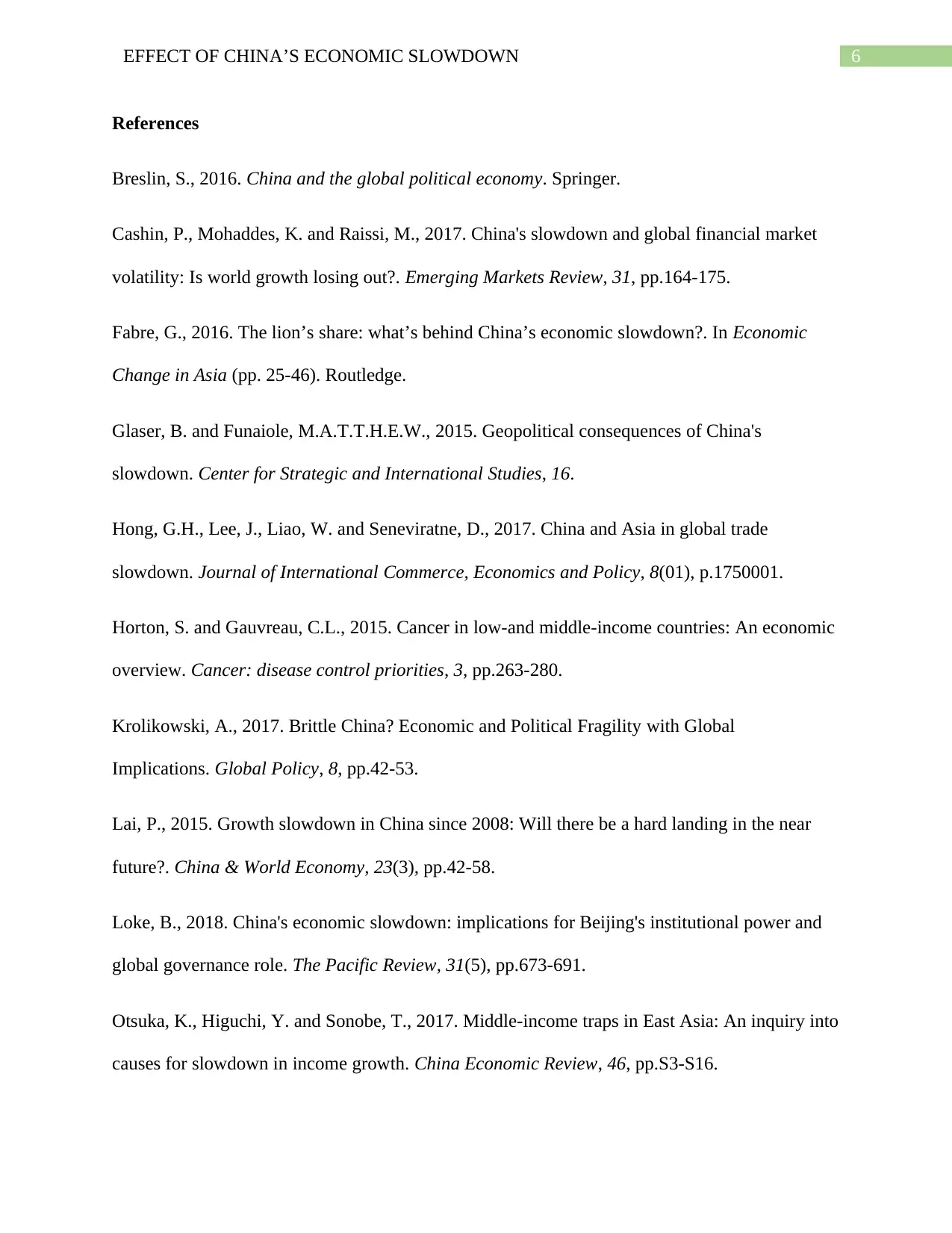
6EFFECT OF CHINA’S ECONOMIC SLOWDOWN
References
Breslin, S., 2016. China and the global political economy. Springer.
Cashin, P., Mohaddes, K. and Raissi, M., 2017. China's slowdown and global financial market
volatility: Is world growth losing out?. Emerging Markets Review, 31, pp.164-175.
Fabre, G., 2016. The lion’s share: what’s behind China’s economic slowdown?. In Economic
Change in Asia (pp. 25-46). Routledge.
Glaser, B. and Funaiole, M.A.T.T.H.E.W., 2015. Geopolitical consequences of China's
slowdown. Center for Strategic and International Studies, 16.
Hong, G.H., Lee, J., Liao, W. and Seneviratne, D., 2017. China and Asia in global trade
slowdown. Journal of International Commerce, Economics and Policy, 8(01), p.1750001.
Horton, S. and Gauvreau, C.L., 2015. Cancer in low-and middle-income countries: An economic
overview. Cancer: disease control priorities, 3, pp.263-280.
Krolikowski, A., 2017. Brittle China? Economic and Political Fragility with Global
Implications. Global Policy, 8, pp.42-53.
Lai, P., 2015. Growth slowdown in China since 2008: Will there be a hard landing in the near
future?. China & World Economy, 23(3), pp.42-58.
Loke, B., 2018. China's economic slowdown: implications for Beijing's institutional power and
global governance role. The Pacific Review, 31(5), pp.673-691.
Otsuka, K., Higuchi, Y. and Sonobe, T., 2017. Middle-income traps in East Asia: An inquiry into
causes for slowdown in income growth. China Economic Review, 46, pp.S3-S16.
References
Breslin, S., 2016. China and the global political economy. Springer.
Cashin, P., Mohaddes, K. and Raissi, M., 2017. China's slowdown and global financial market
volatility: Is world growth losing out?. Emerging Markets Review, 31, pp.164-175.
Fabre, G., 2016. The lion’s share: what’s behind China’s economic slowdown?. In Economic
Change in Asia (pp. 25-46). Routledge.
Glaser, B. and Funaiole, M.A.T.T.H.E.W., 2015. Geopolitical consequences of China's
slowdown. Center for Strategic and International Studies, 16.
Hong, G.H., Lee, J., Liao, W. and Seneviratne, D., 2017. China and Asia in global trade
slowdown. Journal of International Commerce, Economics and Policy, 8(01), p.1750001.
Horton, S. and Gauvreau, C.L., 2015. Cancer in low-and middle-income countries: An economic
overview. Cancer: disease control priorities, 3, pp.263-280.
Krolikowski, A., 2017. Brittle China? Economic and Political Fragility with Global
Implications. Global Policy, 8, pp.42-53.
Lai, P., 2015. Growth slowdown in China since 2008: Will there be a hard landing in the near
future?. China & World Economy, 23(3), pp.42-58.
Loke, B., 2018. China's economic slowdown: implications for Beijing's institutional power and
global governance role. The Pacific Review, 31(5), pp.673-691.
Otsuka, K., Higuchi, Y. and Sonobe, T., 2017. Middle-income traps in East Asia: An inquiry into
causes for slowdown in income growth. China Economic Review, 46, pp.S3-S16.
Paraphrase This Document
Need a fresh take? Get an instant paraphrase of this document with our AI Paraphraser
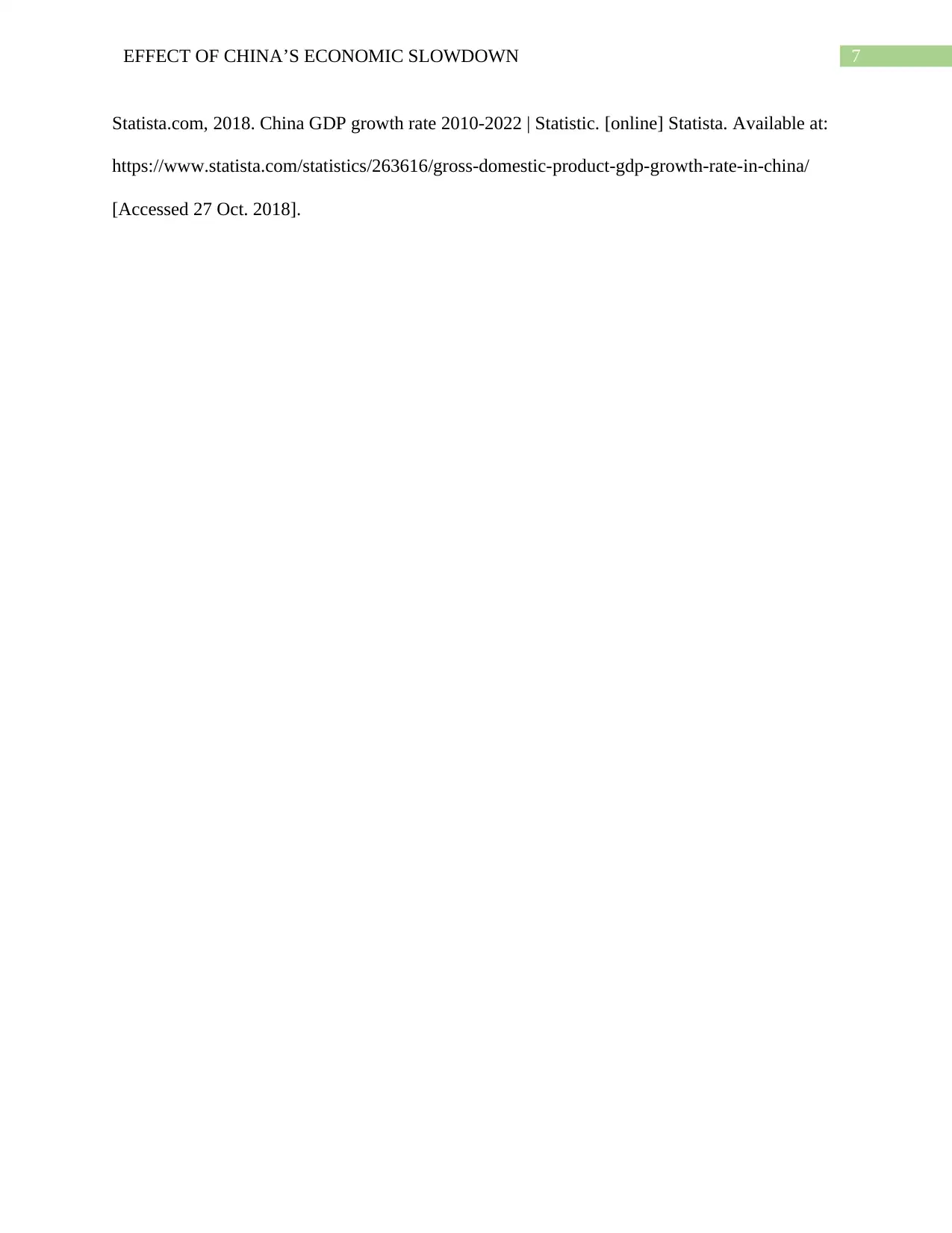
7EFFECT OF CHINA’S ECONOMIC SLOWDOWN
Statista.com, 2018. China GDP growth rate 2010-2022 | Statistic. [online] Statista. Available at:
https://www.statista.com/statistics/263616/gross-domestic-product-gdp-growth-rate-in-china/
[Accessed 27 Oct. 2018].
Statista.com, 2018. China GDP growth rate 2010-2022 | Statistic. [online] Statista. Available at:
https://www.statista.com/statistics/263616/gross-domestic-product-gdp-growth-rate-in-china/
[Accessed 27 Oct. 2018].
1 out of 8
Related Documents
Your All-in-One AI-Powered Toolkit for Academic Success.
+13062052269
info@desklib.com
Available 24*7 on WhatsApp / Email
![[object Object]](/_next/static/media/star-bottom.7253800d.svg)
Unlock your academic potential
Copyright © 2020–2025 A2Z Services. All Rights Reserved. Developed and managed by ZUCOL.




